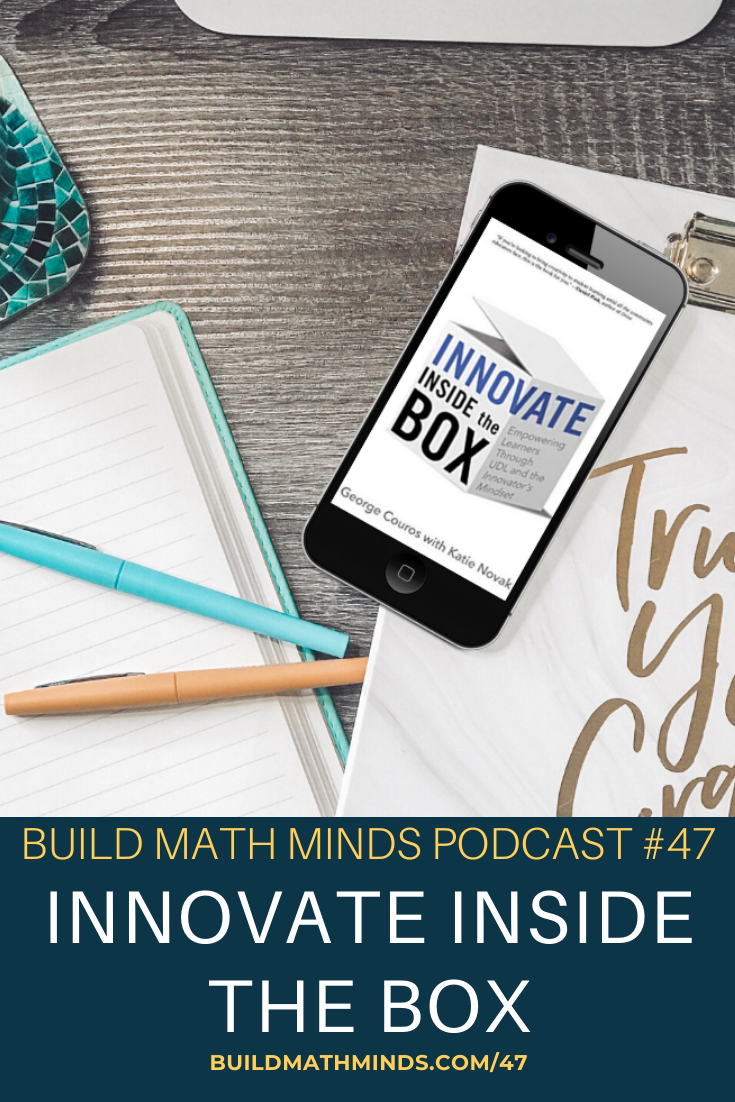Resources mentioned in this episode:
Innovate Inside the Box: Empowering Learners Through UDL and the Innovator’s Mindset by George Couros and Katie Novak
Welcome fellow Recovering Traditionalists to Episode 47. Today we are looking at how to Innovate Inside the Box.
So I’ve started reading a new book and there is so much goodness in this book it was really hard to decide what part to share with you today.
Innovate Inside the Box: Empowering Learners Through UDL and the Innovator’s Mindset by George Couros and Katie Novak is one of those books that makes you think and reflect upon your teaching but it also gives you practical ideas on how to change your teaching.
You know I think math is an important subject. But too often in education we get so focused on teaching the content that it’s hard to remember that we are teaching kids, not the content.
Yes, kids need to develop all the math understandings but HOW you choose to do that can be very “by the book” or you can innovate and create a space where you are developing learners and math is just the vehicle you are using to help them become amazing learners.
Now the biggest thing I hear from people when we talk about building in time for play, creativity, and innovation is all the constraints you have. That’s why I love the title (and the whole content within) this book: Innovate Inside the Box.
Every school, district, state, has certain requirements that you must teach within, but you can still innovate within those requirements. That’s why I picked this specific passage from the book to share with you today, on p.37-38 they write:
So let’s say you have a student who wants to be a “YouTuber,” but you have to teach the science curriculum. Consider having the student create a YouTube video that explains the objective. Not only will you tap into this student’s passion while teaching the curriculum, you will provide the child an opportunity to share her learning with the world—and in creating an opportunity for the student to share her learning, you level up the learning experience another few notches. At a recent conference, Rushton Hurley explained why sharing their learning with a wider audience—like the YouTube universe—matters: “When students do it for the teacher, they want it to be ‘good enough,’ but when they do it for the world, they want it to be ‘good.’” An authentic audience makes the learning relevant and gives purpose to what students create. Many people will say, “This idea of tapping into students’ strengths and passions is great in theory, but we still have to teach the curriculum.” Well, the video example I provided teaches the curriculum while going above and beyond. The curriculum is a “minimum” requirement; it is okay to go above and beyond. But teaching the curriculum while tapping into the strengths and passions of the student is using their abilities to “do your job” while bringing out the best in those you serve. How you teach the curriculum is the innovation.
So yes, we still need to teach the science, the reading, the math, etc but HOW you decide to bring that content to your students is where you can innovate. If you have been wanting to open up the learning more in your classroom but you just aren’t sure how to do it, I highly recommend this book.
Subscribe and Review in iTunes
Hey, are you subscribed to the Build Math Minds Podcast, yet? If you’re not, make sure to do that today because I don’t want you to miss any episodes! Click here to subscribe to the podcast in iTunes.
While you’re there, don’t forget to leave a review on iTunes too. I would love to know your thoughts and how we can make sure that we give you content that you will really enjoy.
To leave a review, head over to iTunes and click on “Ratings and Reviews” and “Write a Review.” I can’t wait to hear your thoughts about the podcast.




